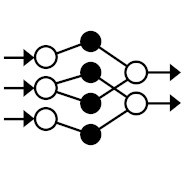Copy Link
Add to Bookmark
Report
Neuron Digest Volume 02 Number 03

NEURON Digest 3 FEBRUARY 1987 Volume 2 Number 3
Topics in this digest --
Replies - genetic search etc.
News - COLOR & VISION NETWORK
Old Discussions - Cottrell's talk at FJCC
Reports/Abstracts - Touretzky/Hinton Tech Report Abstract &
Williams' Tech Report Abstract
Seminars/Courses - Jay McClelland Lecture (CMU ?) &
Cognitive Science Seminar (Dartmouth)
Conferences/Call for papers - AI at upcoming conferences &
IEEE First Annual Conference on Neural Networks
----------------------------------------------------------------------
From: RBA@FLASH.BELLCORE.COM 26-JAN-1987 20:55
To: gately@TI-csl
Subj: genetic search etc.
Your best be would be to contact Dave Ackley who is finishing
his thesis on the comparison of several of these algorithms.
Dave is at CMU and I think you can reach hin at ackley@c.cs.cmu.edu
if that doesn't work, you can probably get to him via
ackley@bellcore.com We have hired him and he already has an
account on our machines.
------------------------------
From: CVNET%YORKVM1.BITNET@WISCVM.WISC.EDU 29-JAN-1987 20:21
To: neuron@ti-csl.csnet
Subj: COLOR & VISION NETWORK
COLOR AND VISION NETWORK
The Color and Vision Network is for scientists working in color and
vision research. At present the Network has three major activities.
1. Members' E-mail addresses are maintained and sent to all
those in the Network.
2. A key word list that associates scientists and their
interests within the areas of color and vision is
maintained and distributed.
3. Any person in the Network can have a bulletin,
announcement, etc, sent to all other people in the
Network.
Scientists working in color and/or vision who wish to join should
contact Peter Kaiser at:
cvnet@yorkvm1 or
cvnet%yorkvm1.bitnet@wiscvm.wisc.edu
They will receive the list of E-mail addresses plus a request to provide
key words which represent their interests and experience in color and/or
vision research.
Scientists from Australia, Canada, Germany, Japan, Netherlands,
Sweden, U.K., and the U.S. are in the Network. They come from universities,
research institutes, national laboratories and private industry. The list
is growing daily.
Peter K. Kaiser
York University
4700 Keele St.
North York, Ontario, M3J 1P3
Canada
pkaiser@yorkvm1.bitnet
pkaiser%yorkvm1.bitnet@wiscvm.wisc.edu
------------------------------
From: COTTRELL%ICS@SDCSVAX.UCSD.EDU 27-JAN-1987 00:03
To: gately@crl1
Subj: Cottrell's talk at FJCC
I just wanted to correct a misapprehension with regards to my talk at FJCC
in Dallas. This was reported on in Vol 1 # 1.
1. There was no paper corresponding to the talk.
2. I do not send troff versions of my papers over the net - figures don't
travel well. I do send troff versions of my (supposedly humorous)
connectionist Dog Modeling seminar announcements.
gary cottrell
Institute for Cognitive Science, UCSD
cottrell@nprdc.arpa (ARPA)
{ucbvax,decvax,akgua,dcdwest}!sdcsvax!sdics!cottrell (USENET)
*****************************************************************
* If connectionist models were objectivized, *
* Only objectivists would have connectionist models *
*****************************************************************
PS Of course, requests for reprints sent by US mail are honored...
------------------------------
From: LAWS@SRI-STRIPE.ARPA 30-JAN-1987 02:13
To: BBoard.Maintainer%a.cs.cmu.edu@CSNET-RELAY.ARPA
Subj: Jay McClelland Lecture (CMU ?)
SPECIAL DEPARTMENTAL SEMINAR:
SPEAKER: Professor James McClelland, CMU Psychology Department
DATE: Monday, February 2
TIME: 3:30 PM
PLACE: Wean Hall 5409
TOPIC: UNDERSTANDING SENTENCES: A PARALLEL DISTRIBUTED PROCESSING APPROACH
ABSTRACT:
Consider the sentence "The boy hit the ball with the bat". This sentence
contains both lexical ambiguity and a syntactic/role assignment ambiguity
(the bat may be an argument of the verb or a constituent of the noun phrase
"the ball with the bat"). Yet most people get a single reading of this
sentence. In general such ambiguity is rampant in natural language and yet
it is rarely noticed.
What kind of mechanism is needed to resolve these ambiguities? In this
talk, I will suggest that Parallel-Distributed Processing (Connectionist)
models have several attractive features which lend themselves well to
handling these and other aspects of natural language understanding. I'll
describe a connectionist network that illustrates some of the promise of this
approach. The network is trained with some example sentences from a corpus
of one-clause sentences (like the one above), then tested for its ability to:
* Assign constituents to the appropriate roles based on surface order and
semantic cues.
* Assign appropriate interpretations to ambiguous words, based on cues
provided by the other words in the sentence.
* Shade the interpretations assigned to words in context.
* Fill in plausible default values for missing arguments based on the
remaining words in the sentence.
* Generalize to new words that share semantic features with words in
the training set.
The network does all of these things rather well within its limited domain,
both for sentences actually used in training and for others presented
only at test. In discussion I will focus on the principles the network
illustrates and on directions for expanding its scope to more complex
corpuses.
COMMENT: There will be no PS Seminar on this date.
------------------------------
From: LAWS@SRI-STRIPE.ARPA 2-FEB-1987 13:11
To: BBoard.Maintainer%a.cs.cmu.edu@CSNET-RELAY.ARPA
Subj: Cognitive Science Seminar (Dartmouth)
SPEAKER: Jamshed Jay Bharucha, Visiting Professor, Darthmouth College
TITLE: "A Connectionist Model of Music Perception & Cognition"
DATE: Tuesday, February 3
TIME: 12:00 - 1:20 p.m.
PLACE: Adamson Wing, Baker Hall
ABSTRACT: A connectionist model will be presented which accounts
for both schematic and sequential processes in music perception,
including expectancies, intuitions of sequential consonance,
and sequential pattern recognition. The model is contrained by
data from earlier experiments on relatedness juidgments and memory
confusions, and is being tested by experiments measuring reaction
time. The interaction between schematic and sequential processes
in this model can be generalized to account for memory for event
sequences in general.
------------------------------
From: TOURETZKY%C.CS.CMU.EDU 2-FEB-1987 16:23
To: connectionists%c.cs.cmu.edu@CSNET-RELAY.ARPA
Subj: Touretzky/Hinton Tech Report Abstract
The following tech report is a successsor to our IJCAI-85 paper ``Symbols Among
the Neurons.'' It describes a more recent, Boltzmann Machine version of our
production system interpreter and goes into considerably more detail than the
IJCAI paper. Copies may be ordered at no charge from the Computer Science
Department, Carnegie Mellon University, Pittsburgh, PA, 15213. Ask for
technical report CMU-CS-86-172.
A Distributed Connectionist Production System
David S. Touretzky and Geoffrey E. Hinton
Carnegie Mellon University
DCPS is a connectionist production system interpreter that uses distributed
representations. As a connectionist model it consists of many simple, richly
interconnected neuron-like computing units that cooperate to solve problems in
parallel. One motivation for constructing DCPS was to demonstrate that
connectionist models are capable of representing and using explicit rules. A
second motivation was to show how ``coarse coding'' or ``distributed
representations'' can be used to construct a working memory that requires far
fewer units than the number of different facts that can potentially be stored.
The simulation we present is intended as a detailed demonstration of the
feasibility of certain ideas and should not be viewed as a full implementation
of production systems. Our current model only has a few of the many
interesting emergent properties that we eventually hope to demonstrate: it is
damage resistant, it performs matching and variable binding by massively
parallel constraint satisfaction, and the capacity of its working memory is
dependent on the similarity of the items being stored.
------------------------------
From: RJW@CORWIN.CCS.NORTHEASTERN.EDU 1-FEB-1987 21:40
To: connectionists%c.cs.cmu.edu@CSNET-RELAY.ARPA
Subj: Williams' Tech Report Abstract
REINFORCEMENT-LEARNING CONNECTIONIST SYSTEMS
Ronald J. Williams
College of Computer Science
Northeastern University
360 Huntington Ave.
Boston, MA 02115
rjw@corwin.ccs.northeastern.edu
(Tech. Rep. NU-CCS-87-3)
This report begins by discussing a number of issues concerning learning
algorithms for connectionist systems. In particular, the need for
algorithms which train temporally extended behaviors and which are
capable of on-line implementation is argued. Then this report presents
an interesting general class of associative reinforcement learning
algorithms, which apply to systems where the units operate stochastically
and the training feedback consists of scalar reinforcement signals.
What makes these algorithms interesting is that: (1) they statistically
follow the gradient of a natural performance measure for associative
reinforcement learning problems, making them analogues for such problems
of the back-propagation learning procedure for supervised learning problems;
(2) they admit a simple on-line implementation even when applied to the
problem of training temporally extended behaviors, which is not true for
the back-propagation algorithm; and (3) certain algorithms studied elsewhere
belong to this class, including the reward-inaction variant of Barto's
reward-penalty algorithm, some stochastic learning automata algorithms,
and variants of these in which Sutton's reinforcement comparison methods
are used. Furthermore, while Sutton's promising adaptive heuristic critic
algorithm is not a member of this class, ways the theory presented here
might nevertheless help provide needed mathematical insight into its
behavior are discussed. Finally, some particular implications of this
theory for the development of novel learning algorithms are noted.
------------------------------
Date: WED, 10 oct 86 17:02:23 CDT
From: leff%smu@csnet-relay
Subject: AI at upcoming conferences
_____
Compcon 87 Cathedral Hill Hotel, San Francisco, February 23-27
Tutorial Number 3 on AI Machines: Instructor David Elliot Shaw of the
Columbia University Non-Von Project
Tutorial Number 7: Managing Knowledge Systems Development: Instructor
Avron Barr
1:30 - 3:00 February 25
A Neural Based Knowledge Processor - J. Vovodsky Neuro Logic Inc.
Connectionists, Symbol Processsing in Neural Based Architectures
D. Touretzky, Carnegie-Mellon Univ.
Dr awbacks with Neural Based Architectures - D. Partridge New Mexico State
University
Timing Dependencies in Sentence Comprehension - H. Gigly, University of
New Hampshire
Optical Neural Networks D. Psaltis: California Institute of Technology
------------------------------
From: MIKEB@NPRDC.ARPA 29-JAN-1987 20:18
To: neuron@ti-csl
Subj: IEEE First Annual Conference on Neural Networks
IEEE First Annual International Conference on Neural Net-
works, San Diego, California, 21-24 June 1987. Revised dead-
lines for abstracts and papers.
Extended abstracts should be submitted for conference
presentation by April 1, 1987.
Abstracts received after April 1, 1987 will be
returned.
Please submit abstract plus 4 clean copies. Abstracts
must be neatly typed, single spaced, three to four
pages.
Abstracts will be carefully refereed. Authors of
accepted abstracts will be notified in the first week
of May.
Final papers for publication in the book of proceedings
are due June 21, 1987. A copyright release must be
signed before June 21, 1987.
The proceedings will be published in the Fall of 1987.
Address all correspondence referring to abstracts and
papers to: Maureen Caudill, IEEE-ICNN, 10615G Tierra-
santa Blvd., Suite 346, San Diego, CA 92124
Telephone: (619) 457-5550, ext. 221
------------------------------
End of NEURON Digest
********************





















